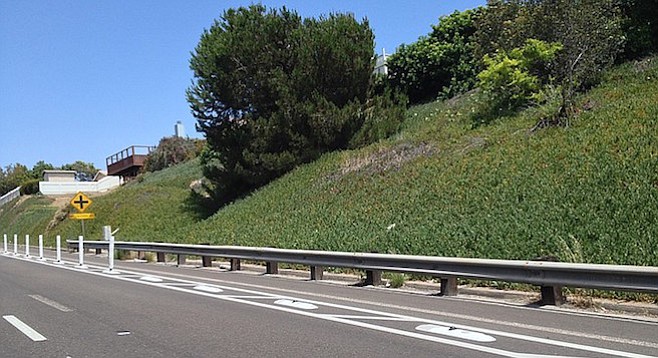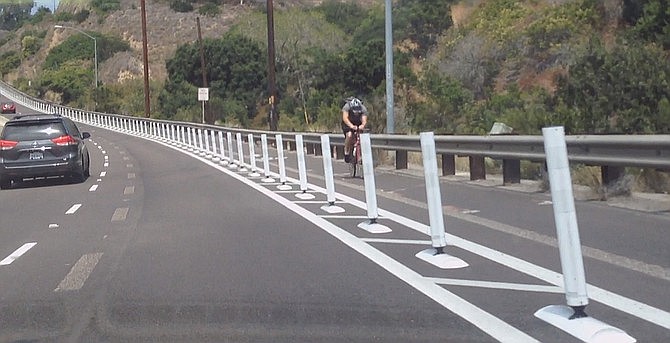 Facebook
Facebook
 X
X
 Instagram
Instagram
 TikTok
TikTok
 Youtube
Youtube

On May 24, the city installed white plastic barriers along the bike lane on one side of Balboa Avenue (east on Clairemont Drive heading toward Genesee Avenue). Within a few days, the barriers started getting wiped out by motorists.
Driving down the mile-long stretch on July 1, the first and last barriers were missing as well as nearly 30 others. There were also an additional 50 or so that were worse for wear, either leaning over or with tire marks. There were also 28 pairs of swerving skid marks heading toward the barriers the entire way.

“Maybe they're being hit simply because the lanes are too narrow now,” said Clairemont resident Tracy Cullen. “Twice now, I’ve had people drift into my lane. Maybe it's just because I was used to having more room, but the lanes now feel way too tight. There is no shoulder on either side now. What are motorists supposed to do if they break down and need to pull over?”
On June 10, Keith Hartz from the Clairemont Community Planning Group emailed the city as a private citizen about the barriers. In his email to Mario Sierra (director of environmental services) and councilmember Chris Cate, Hartz stated, “The dividers have provided pedestrians with a false sense of security, as they have now been using this as a path to traverse this canyon. I've personally seen more adults walking this bike lane than I've ever seen before. I've also been told that kids are using this path to walk to the middle and high schools. Before conversion, any attempts by pedestrians were at least behind the guard rail, providing a lot more protection than they have now. Those bike-separation poles will in no way stop or deter any cars that end up crossing over them. This is a disaster waiting to happen.”
City traffic engineer Gary Chui called Hartz to discuss his email. Hartz said he was told, “The city studied it and said they are going to add more lighting, V-Calm signs, and eventually a camera to monitor what's going on.”
When asked what he thought would have been a better option, Hartz said, “Leave it as it was — that was probably the best option. Not sure why this one was chosen.”
Bill Harris of the city's Street Division explained what the transportation engineering operations team had to say about the matter. When asked why the barriers were chosen and what other options were considered, Harris said, “The Bike Master Plan calls for a bike lane for Balboa Avenue within this limit. These delineators [barriers] upgraded the facility to cycle track. This improvement is in accordance with the Balboa Avenue Revitalization Action Plan. Other options considered include installation of a sidewalk behind the existing guard rail.” The estimated cost for this sidewalk is roughly $6.0 to $6.5 million, Harris added.
When I mentioned the concern of some drivers with the lanes feeling a little tight, Harris responded, “There is a speeding issue within this segment of Balboa. The delineator creates a visual traffic-calming effect. They make the lane seem narrower than it actually is. We will be conducting a speed survey to see the effectiveness on motorists' speed.”
Regarding safety measures to be implemented, Harris said, “The cameras were installed this week and we are monitoring this location. We are working with the city crew to install the V-Calm signs. Streetlights will be purchased in FY17.”
When it comes to the barriers that have been downed, Harris said, “We have visited the site with representatives from the delineator's manufacturer. They will be replaced at no cost to the city. The city will monitor the situation and replace the damaged barriers on an as-needed basis.”
Harris said there are no plans to install any like barriers elsewhere in Clairemont.
As a pedestrian, Lisa Fredsti of Bay Park said, ”To say that Balboa isn’t friendly for walkers minimizes how dangerous and unpleasant it is in stretches. I’ve walked behind the old guardrail up Balboa and there’s not a lot of room to walk. Balboa is a major route to shopping and restaurants and really one of the only options for pedestrians to get to Balboa and Genesee or down to Pacific Beach. Whatever measures the city is taking to help cyclists on Balboa should include the needs of pedestrians as well. San Diego needs to be made more pedestrian-friendly as well as bike-friendly.”


On May 24, the city installed white plastic barriers along the bike lane on one side of Balboa Avenue (east on Clairemont Drive heading toward Genesee Avenue). Within a few days, the barriers started getting wiped out by motorists.
Driving down the mile-long stretch on July 1, the first and last barriers were missing as well as nearly 30 others. There were also an additional 50 or so that were worse for wear, either leaning over or with tire marks. There were also 28 pairs of swerving skid marks heading toward the barriers the entire way.

“Maybe they're being hit simply because the lanes are too narrow now,” said Clairemont resident Tracy Cullen. “Twice now, I’ve had people drift into my lane. Maybe it's just because I was used to having more room, but the lanes now feel way too tight. There is no shoulder on either side now. What are motorists supposed to do if they break down and need to pull over?”
On June 10, Keith Hartz from the Clairemont Community Planning Group emailed the city as a private citizen about the barriers. In his email to Mario Sierra (director of environmental services) and councilmember Chris Cate, Hartz stated, “The dividers have provided pedestrians with a false sense of security, as they have now been using this as a path to traverse this canyon. I've personally seen more adults walking this bike lane than I've ever seen before. I've also been told that kids are using this path to walk to the middle and high schools. Before conversion, any attempts by pedestrians were at least behind the guard rail, providing a lot more protection than they have now. Those bike-separation poles will in no way stop or deter any cars that end up crossing over them. This is a disaster waiting to happen.”
City traffic engineer Gary Chui called Hartz to discuss his email. Hartz said he was told, “The city studied it and said they are going to add more lighting, V-Calm signs, and eventually a camera to monitor what's going on.”
When asked what he thought would have been a better option, Hartz said, “Leave it as it was — that was probably the best option. Not sure why this one was chosen.”
Bill Harris of the city's Street Division explained what the transportation engineering operations team had to say about the matter. When asked why the barriers were chosen and what other options were considered, Harris said, “The Bike Master Plan calls for a bike lane for Balboa Avenue within this limit. These delineators [barriers] upgraded the facility to cycle track. This improvement is in accordance with the Balboa Avenue Revitalization Action Plan. Other options considered include installation of a sidewalk behind the existing guard rail.” The estimated cost for this sidewalk is roughly $6.0 to $6.5 million, Harris added.
When I mentioned the concern of some drivers with the lanes feeling a little tight, Harris responded, “There is a speeding issue within this segment of Balboa. The delineator creates a visual traffic-calming effect. They make the lane seem narrower than it actually is. We will be conducting a speed survey to see the effectiveness on motorists' speed.”
Regarding safety measures to be implemented, Harris said, “The cameras were installed this week and we are monitoring this location. We are working with the city crew to install the V-Calm signs. Streetlights will be purchased in FY17.”
When it comes to the barriers that have been downed, Harris said, “We have visited the site with representatives from the delineator's manufacturer. They will be replaced at no cost to the city. The city will monitor the situation and replace the damaged barriers on an as-needed basis.”
Harris said there are no plans to install any like barriers elsewhere in Clairemont.
As a pedestrian, Lisa Fredsti of Bay Park said, ”To say that Balboa isn’t friendly for walkers minimizes how dangerous and unpleasant it is in stretches. I’ve walked behind the old guardrail up Balboa and there’s not a lot of room to walk. Balboa is a major route to shopping and restaurants and really one of the only options for pedestrians to get to Balboa and Genesee or down to Pacific Beach. Whatever measures the city is taking to help cyclists on Balboa should include the needs of pedestrians as well. San Diego needs to be made more pedestrian-friendly as well as bike-friendly.”
Comments